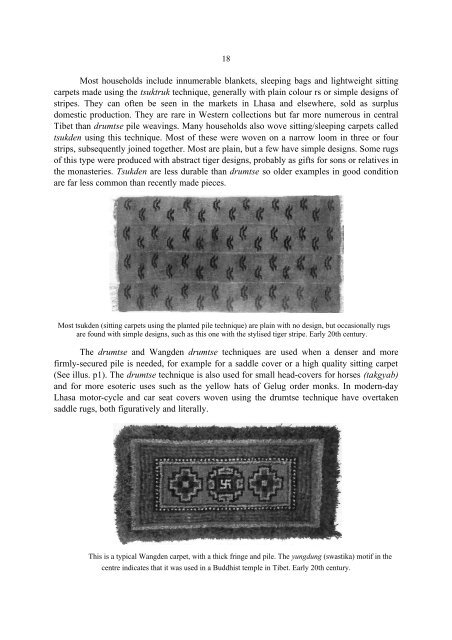download - OATG. Oxford Asian Textile Group
download - OATG. Oxford Asian Textile Group
download - OATG. Oxford Asian Textile Group
- No tags were found...
You also want an ePaper? Increase the reach of your titles
YUMPU automatically turns print PDFs into web optimized ePapers that Google loves.
18Most households include innumerable blankets, sleeping bags and lightweight sittingcarpets made using the tsuktruk technique, generally with plain colour rs or simple designs ofstripes. They can often be seen in the markets in Lhasa and elsewhere, sold as surplusdomestic production. They are rare in Western collections but far more numerous in centralTibet than drumtse pile weavings. Many households also wove sitting/sleeping carpets calledtsukden using this technique. Most of these were woven on a narrow loom in three or fourstrips, subsequently joined together. Most are plain, but a few have simple designs. Some rugsof this type were produced with abstract tiger designs, probably as gifts for sons or relatives inthe monasteries. Tsukden are less durable than drumtse so older examples in good conditionare far less common than recently made pieces.Most tsukden (sitting carpets using the planted pile technique) are plain with no design, but occasionally rugsare found with simple designs, such as this one with the stylised tiger stripe. Early 20th century.The drumtse and Wangden drumtse techniques are used when a denser and morefirmly-secured pile is needed, for example for a saddle cover or a high quality sitting carpet(See illus. p1). The drumtse technique is also used for small head-covers for horses (takgyab)and for more esoteric uses such as the yellow hats of Gelug order monks. In modern-dayLhasa motor-cycle and car seat covers woven using the drumtse technique have overtakensaddle rugs, both figuratively and literally.This is a typical Wangden carpet, with a thick fringe and pile. The yungdung (swastika) motif in thecentre indicates that it was used in a Buddhist temple in Tibet. Early 20th century.
















